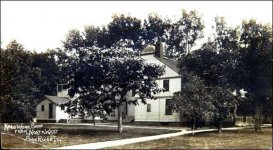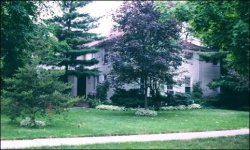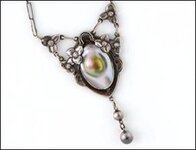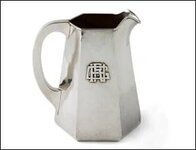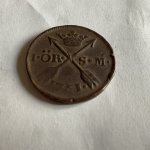Gypsy Heart
Gold Member
I would be begging for permission to hunt this property
The Kalo Shop was founded in 1900 in Chicago by 32-year old Clara P. Barck. From a January, 1901 article in the Chicago Daily Tribune:
"The Kalo company is the latest group to be formed. It is composed of six young women, Bertha Hall, Rose Dolese, Grace Gerow, Clara P. Barck, Ruth Raymond, and Bessie McNeal, and their company name is taken from a Greek word meaning "to make beautiful." They are all graduates of the designers' course at the Art Institute, and besides designing for wall decoration, produce articles in burnt wood and decorated leather. The workshop of the Kalo company is in the Bank of Commerce Building."
In addition to pyrography and leatherwork, Barck initially sold textiles, copper items, baskets, and jewelry. In 1905, Barck married George Welles, a coal merchant and amateur silversmith. In 1907 she bought the house shown below to serve as the workshop for the Kalo Arts Crafts Community in Park Ridge. When Clara and George divorced in 1914 and the Shop moved to Chicago, George convinced her to focus exclusively on the handwrought copper and silver items for which it is best known. In 1912 Kalo opened a branch store in New York that lasted only until 1916 because of war constraints (date and early information courtesy of Chicago metalcraft expert Darcy Evon).
While other silversmiths like Randahl sold co-branded products through department stores, the Kalo Shop did not. In the late 1920s Welles tried creating several dozen Danish-influenced items she called the Norse Line to sell through other merchants, but the onset of the Depression ended this venture prematurely. (Norse Line products -- usually marked with an NS in addition to the Kalo stamp -- are rare.) The Shop had a loyal clientele that helped it thrive through the troubled 1930s when many other silversmiths failed.
Welles retired to Mission Hills, California in 1939. In 1959, six years before she passed away, she turned the shop over to four of her craftsmen, Robert Bower, Daniel Pederson, Arne Myhre, and Yngve Olsson. When Pederson and Olsson died in 1970, the store closed for good.
In an interview in the Summer 1992 issue of American Silversmith, Bower, who managed the operation for its final 30 years, explained why the Shop shut down. "We ran out of silversmiths. In the last year we lost our three top silversmiths; men who could not be replaced. It was difficult trying to find men willing to learn silversmithing and it took years to train them."
The Kalo Shop produced handwrought flatware, holloware and jewelry, and trained or worked with noted Chicago metalsmiths such as Julius Randahl, Grant Wood, Esther Meacham, Matthias Hanck, Falick Novick, Heinrich Eicher, and Emery Todd. In the early years most of the output was copper, but quickly changed to silver. It also produced fine gold jewelry. Kalo objects have a timeless, elegant style that seems modern today even though many pieces were made nearly a century ago.
The Kalo Shop began producing handwrought metal objects along with other crafts in 1900 The first mark was KALO -- or in rare cases KALO STERLING, since the output of the Shop back then was largely copper. This was soon followed for a few years by HAND BEATEN / AT / THE KALO SHOP / PARK RIDGE / ILLS. In 1912, when the Shop opened a store on 54th Street in New York City, the mark was changed to HAND WROUGHT / AT / THE KALO SHOPS / CHICAGO / AND / NEW YORK.
The Kalo Shop was founded in 1900 in Chicago by 32-year old Clara P. Barck. From a January, 1901 article in the Chicago Daily Tribune:
"The Kalo company is the latest group to be formed. It is composed of six young women, Bertha Hall, Rose Dolese, Grace Gerow, Clara P. Barck, Ruth Raymond, and Bessie McNeal, and their company name is taken from a Greek word meaning "to make beautiful." They are all graduates of the designers' course at the Art Institute, and besides designing for wall decoration, produce articles in burnt wood and decorated leather. The workshop of the Kalo company is in the Bank of Commerce Building."
In addition to pyrography and leatherwork, Barck initially sold textiles, copper items, baskets, and jewelry. In 1905, Barck married George Welles, a coal merchant and amateur silversmith. In 1907 she bought the house shown below to serve as the workshop for the Kalo Arts Crafts Community in Park Ridge. When Clara and George divorced in 1914 and the Shop moved to Chicago, George convinced her to focus exclusively on the handwrought copper and silver items for which it is best known. In 1912 Kalo opened a branch store in New York that lasted only until 1916 because of war constraints (date and early information courtesy of Chicago metalcraft expert Darcy Evon).
While other silversmiths like Randahl sold co-branded products through department stores, the Kalo Shop did not. In the late 1920s Welles tried creating several dozen Danish-influenced items she called the Norse Line to sell through other merchants, but the onset of the Depression ended this venture prematurely. (Norse Line products -- usually marked with an NS in addition to the Kalo stamp -- are rare.) The Shop had a loyal clientele that helped it thrive through the troubled 1930s when many other silversmiths failed.
Welles retired to Mission Hills, California in 1939. In 1959, six years before she passed away, she turned the shop over to four of her craftsmen, Robert Bower, Daniel Pederson, Arne Myhre, and Yngve Olsson. When Pederson and Olsson died in 1970, the store closed for good.
In an interview in the Summer 1992 issue of American Silversmith, Bower, who managed the operation for its final 30 years, explained why the Shop shut down. "We ran out of silversmiths. In the last year we lost our three top silversmiths; men who could not be replaced. It was difficult trying to find men willing to learn silversmithing and it took years to train them."
The Kalo Shop produced handwrought flatware, holloware and jewelry, and trained or worked with noted Chicago metalsmiths such as Julius Randahl, Grant Wood, Esther Meacham, Matthias Hanck, Falick Novick, Heinrich Eicher, and Emery Todd. In the early years most of the output was copper, but quickly changed to silver. It also produced fine gold jewelry. Kalo objects have a timeless, elegant style that seems modern today even though many pieces were made nearly a century ago.
The Kalo Shop began producing handwrought metal objects along with other crafts in 1900 The first mark was KALO -- or in rare cases KALO STERLING, since the output of the Shop back then was largely copper. This was soon followed for a few years by HAND BEATEN / AT / THE KALO SHOP / PARK RIDGE / ILLS. In 1912, when the Shop opened a store on 54th Street in New York City, the mark was changed to HAND WROUGHT / AT / THE KALO SHOPS / CHICAGO / AND / NEW YORK.


